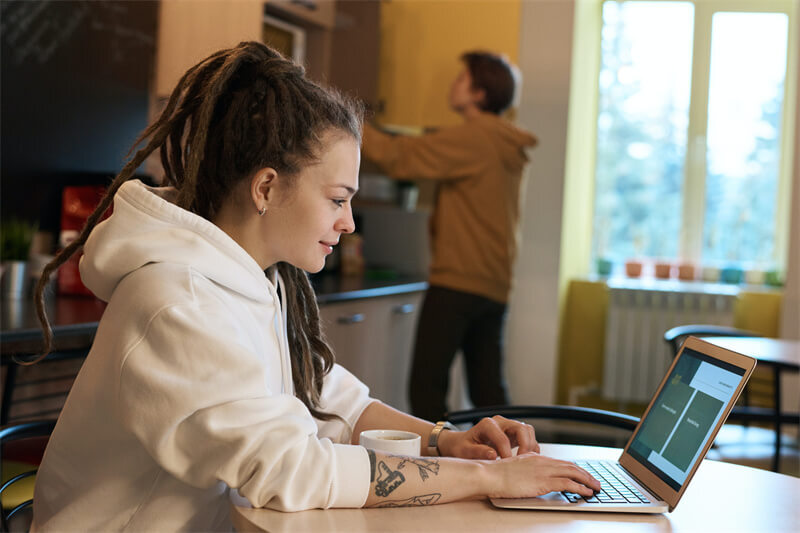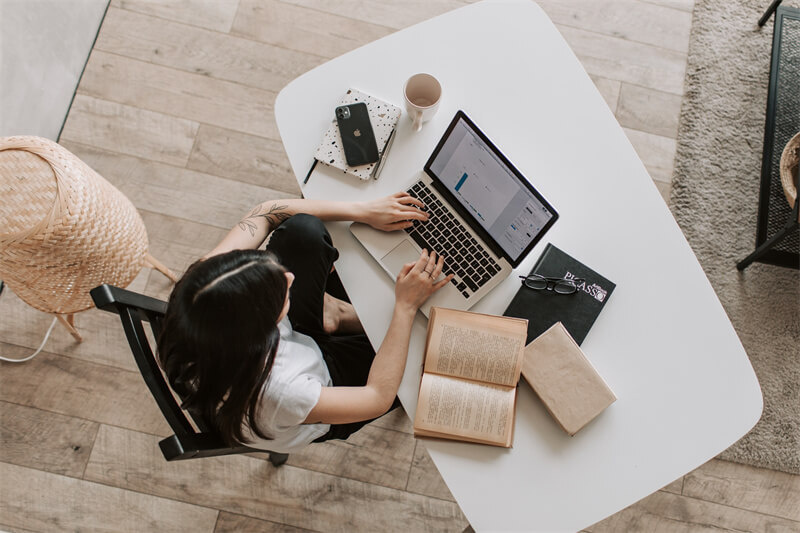Best Home Office Setup 2025 - Complete Guide

These days, a lot of people work from home. But staying focused and comfortable can be hard without the right setup. That's where a good home office setup makes all the difference. It goes beyond having just a table and a chair. Instead, it is about creating a space that helps you do your best work. Whether you are writing, designing, managing tasks, or attending meetings, the best home office setup can help you stay productive and feel better while working.
In this article, we will show you what you need and share tips to make your workspace more effective and comfortable.
Part 1: Home Office Setup Overview
| Item | Why It's Essential | What to Look For |
|---|---|---|
| Desk & Chair | Foundation for comfort and health; prevents back pain and fatigue. | Desk: 47"+ width, cable management. Chair: Adjustable lumbar, height, armrests. |
| Computer | Your primary tool; performance dictates your workflow speed. | Match RAM & CPU to your job (8GB for writing, 16GB+ for design/coding). |
| Webcam & Audio | Critical for professionalism in meetings and clear communication. | Webcam: 4K, AI tracking. Audio: Noise-canceling mic/headphones. |
| Lighting & Wi-Fi | Reduces eye strain, improves appearance, and ensures a stable connection. | Light: Adjustable desk lamp. Wi-Fi: Dual-band router + VPN. |
Key Points to Consider for Building an Efficient and Productive Home Office
Focus on these points to build an efficient home office:
- Prioritize Ergonomics: Your chair and desk are long-term health investments. Don't compromise.
- Match Tech to Your Job: A video editor needs a different computer than a writer.
- Invest in Your Video Presence: A good webcam (like the OBSBOT Tiny 2) and microphone instantly boost professionalism.
- Control Your Environment: Good lighting and a reliable internet connection are non-negotiable for focus and reliability.
- Declutter Digitally & Physically: A tidy desk and organized software stack reduce mental load and save time.
Part 2: Essential Items You Need for a Home Office Setup
1. Office Desk
Choose a desk that adapts to your work style, not just any desk. For a home office desk setup, rather than "get a desk," choose one that adapts to your working habits. If you're on video calls or typing all day, an adjustable-height desk (preferably electric) can help you switch to standing mode, boosting alertness and reducing fatigue.
Aim for at least 120 cm / 47″ width, which gives enough room for a monitor, laptop, and notebook.
You may also look for built-in cable management (like trays or grommets) to avoid tangled cords and keep your workspace clean, as a tidy desk can reduce distractions and stress.
2. Office Chair
Invest in an ergonomic chair—it's cheaper than chiropractor bills. Think of your chair as a long-term investment in comfort. For remote work, opt for an ergonomic chair with:
- Lumbar support to protect your lower back
- Height adjustment so your feet sit flat
- A reclining base and cushioned armrests for movement
A breathable mesh back combined with dense foam in the seat helps with endurance and comfort. Look out for a class 4 gas lift for dependable height control. Competitive models in the $200–$400 range (like certain Secretlab or Herman Miller alternatives) often outperform cheaper options, saving your back and potentially costly chiropractor bills.
3. Laptop/PC
Your computer choice depends entirely on your job. Don't overpay for power you don't need.
| Job Type | Recommended Specs | Key Rationale |
|---|---|---|
| Writers, Social Media Managers | 8GB RAM, SSD Storage | Handles browsers, documents, and communication apps smoothly without cost. |
| Graphic Designers, Video Editors | 16-32GB RAM, Dedicated GPU or M-series Mac | Manages large files and rendering without lag; needs color accuracy. |
| Software Developers, Data Analysts | Multi-core CPU, Fast SSD, 16GB+ RAM | Speeds up compiling, data processing, and multitasking with multiple IDEs. |
When choosing a laptop for your home office configuration, your choice depends on your productivity setup. Pair your device with a monitor featuring an IPS panel and 99% sRGB coverage for crisp visuals and accurate colors. A USB-C docking station can make switching between mobile and desktop setups seamless.
4. Webcam
A dedicated webcam dramatically improves your professional appearance on video calls. A standalone Webcam provides higher video clarity than a laptop's built-in webcam, making it a worthwhile investment for telecommuters who need to conduct frequent meetings, teach classes, or create video content that not only improves picture quality but also enhances a sense of trust and professionalism.
Recommended: OBSBOT Tiny 2 4K Webcam
OBSBOT Tiny 2 is a premium AI webcam that helps you look and sound professional in any remote setting. It's designed for clarity, convenience, and intelligent automation — perfect for modern home office workflows.
Key Features of OBSBOT Tiny 2:
- 4K Resolution: Delivers vivid, professional-looking visuals that help you present with confidence in every meeting.
- AI Auto-Framing and Subject Tracking: Keeps you perfectly centered as you move, ideal for active presenters or multitaskers.
- Gesture & Voice Control: Lets you manage camera angles and zoom hands-free, so you can stay focused on your work without interrupting flow.
- Dual Noise-Reducing Microphones: Ensures your voice sounds clear in meetings — it is a clean and efficient solution for any home setup.
- Low Light Shooting: The Tiny 2 stands out as a powerful low-light webcam, using dual native ISO technology to capture high dynamic range images with low noise in dark settings.
5. Keyboard and Mouse
Comfortable input devices reduce fatigue and boost productivity during long work sessions. Long typing sessions demand comfort and precision. Here's what to look for:
- Mechanical or scissor-switch keyboards for responsive, fatigue-free typing
- A contoured mouse with a thumb rest and additional buttons if you're editing or multitasking
- Wireless models cut down on clutter. Choose those with long battery life and Bluetooth that pairs with multiple devices
Even switching to a quieter, ergonomic option can reduce wrist strain and boost typing speed and comfort.
6. Headphones
Noise-canceling headphones help you focus and ensure clear communication. Whether you're on calls or need focus while working, headphones matter. Go for:
- Active Noise Cancellation (ANC) to block household or traffic noise
- Comfortable over-ear design for long sessions
- Models with a built-in mic. Some offer professional-grade audio (like Jabra or Sony models) without breaking the bank
7. Microphones
A dedicated USB microphone dramatically improves your audio quality on calls. Built-in laptop mics are okay for casual chats, but if you conduct interviews, teach, or record audio, a USB mic like the Blue Yeti brings quality and clarity. Choose one with a cardioid pickup pattern to focus on your voice. It is a bonus if it includes a pop filter and boom arm, which greatly reduce unwanted noise and improve speech quality.
8. Printer
Only get a printer if you regularly need physical copies; otherwise, it's an unnecessary expense. Need printouts or paper drafts? Go for a compact all-in-one wireless printer with automatic duplexing. Laser models are fast and cost-effective for frequent use, while inkjets are still better for occasional printing with occasional photos. The right print setup saves trips to the store and maintains privacy/security.
9. Lighting
Good lighting reduces eye strain and makes you look better on video calls. Proper lighting can prevent eye strain and improve your appearance during calls:
- Use a desk lamp with adjustable color temperature. You can opt for warm light for calm work, cool white for focus.
- An LED panel or ring light placed just above your monitor can enhance face lighting for video meetings.
- Avoid glare by positioning lights sideways. Bias lighting behind your monitor also supports eye health.
10. Wi-Fi & VPNs
A reliable internet connection and VPN are non-negotiable for remote work. Nothing disrupts productivity faster than a slow or unsecured connection. A dual-band router (2.4 GHz + 5 GHz) helps manage bandwidth. Others in the household must be streaming. A trusted VPN (like NordVPN or ExpressVPN) guards sensitive company data and grants secure access to work networks from home.
11. Plants
A simple plant can improve mood and air quality with minimal effort. A small plant, like a succulent or pothos, brightens the space and improves mood. No need to overthink it; low-maintenance varieties add a touch of calm without extra effort.
Part 3: More Home Office Tips to Help You Be More Productive
1. Choose a Dedicated Workspace
Designate a specific area for work to create mental boundaries between work and personal life. Whether it's a spare room or a quiet corner, designating a consistent spot for work helps your mind shift into "focus mode." It also creates a psychological boundary between work and rest, which is vital for preventing burnout. Even a small nook with a comfortable chair, desk, and good lighting can become your productivity zone.
Note: Face your desk toward a wall or window to reduce distractions, and avoid working from your bed or couch, your brain associates those with downtime, not deadlines.
2. Keep Your Desk Tidy
A clean workspace reduces mental clutter and improves focus. Visual clutter can lead to mental clutter. A neat desk:
- Makes you feel more in control
- Speeds up your ability to find things
- Supports better thinking and decision-making
Use simple tools like cable clips, under-desk trays, and small organizers for stationery and gadgets. A minimalist setup reduces friction. Every time you don't have to search for something, you save brainpower for real work.
3. Install Essential Software Tools
Use these four types of apps to build your digital workflow and save hours each week.
| Category | Purpose | Top Picks |
|---|---|---|
| Communication | Team chats & video calls | Slack, Zoom, Microsoft Teams |
| Task Management | Organize projects & deadlines | Trello, Asana, Notion |
| File Sharing | Cloud storage & collaboration | Google Drive, Dropbox |
| Time Tracking | Audit and improve time use | Toggl, RescueTime |
Note: Use desktop shortcuts, keyboard macros, or launchers (like Alfred or PowerToys Run) to access tools faster. This adds up to saved hours weekly.
4. Use Dual Monitors (if possible)
A second monitor is one of the biggest productivity boosts for remote workers. It may seem like a luxury, but a second screen is one of the biggest productivity boosts you can get at home. Studies show dual monitors can improve efficiency by up to 42%.
Here's why:
- You can reference one screen (e.g., research, email, video call) while working on the other
- Drag-and-drop becomes seamless between apps or files
- Designers, coders, analysts, and writers all benefit from less app switching
Note: Even a portable USB-C monitor can work wonders if you're short on space.
Part 4: FAQs About Home Office Setup
1. What is an ideal home office setup?
A dedicated workspace with an ergonomic chair, adjustable desk, and tech tools suited to your job, plus good lighting and internet. The ideal setup varies by individual needs but should always include ergonomic furniture to support your body during long work hours, technology that matches your work requirements, and environmental elements that promote focus and well-being.
2. What is the best room in the house for a home office?
Choose a quiet room with natural light, away from high-traffic areas. Select a space with minimal household traffic and noise. If a dedicated room isn't available, use room dividers or bookshelves to create a visual separation from living areas. Natural light is beneficial, but position your desk to avoid glare on screens.
3. How much does a home office setup cost?
A functional setup costs between $500 and $3,000+, depending on your needs and profession.
- Budget Setup ($500 - $1,000): Covers the basics: a simple desk, ergonomic chair, entry-level laptop, and essential peripherals. Suited for roles that primarily need a computer and the internet.
- Mid-Range Setup ($1,500 - $2,500): Includes upgrades that boost productivity and comfort: a standing desk, high-quality chair, external monitor, better webcam, and dedicated microphone.
- Premium/Professional Setup ($3,000+): For power users. Includes high-end computing (for design/editing), dual monitors, professional audio/video equipment, and top-tier furniture.
4. Which way should a desk face in a home office?
Face your desk toward natural light sources, but avoid direct glare on screens. Ideally, position your desk to benefit from natural light without it shining directly on your monitor. If possible, avoid facing a blank wall for an extended period, as it can feel confining. Some prefer facing the entrance to their workspace for a sense of awareness and control.
Conclusion
Your home office setup doesn't need to be fancy. It just needs to work for you. From ergonomic furniture to reliable tech and good lighting, every element should support your comfort and focus. You can use what fits your space and job type. Once your setup feels right, you'll notice better energy, fewer distractions, and more productive days ahead.














